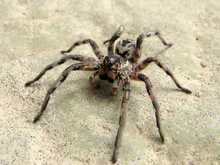| Lycosa tarantula | |
|---|---|

| |
| Scientific classification | |
| Domain: | Eukaryota |
| Kingdom: | Animalia |
| Phylum: | Arthropoda |
| Subphylum: | Chelicerata |
| Class: | Arachnida |
| Order: | Araneae |
| Infraorder: | Araneomorphae |
| Family: | Lycosidae |
| Genus: | Lycosa |
| Species: | L. tarantula
|
| Binomial name | |
| Lycosa tarantula | |
| Synonyms[1] | |
| |


Lycosa tarantula is the species originally known as the tarantula, a name that nowadays in English commonly refers to spiders in another family entirely, the Theraphosidae. It now may be better called the tarantula wolf spider, being in the wolf spider family, the Lycosidae. L. tarantula is a large species found in southern Europe, especially in the Apulia region of Italy and near the city of Taranto, from which it gets its name.[2]
Historical superstition has it that the spider's bite can produce severe symptoms called tarantism.
- ^ "Taxon details Lycosa tarantula (Linnaeus, 1758)". World Spider Catalog. Natural History Museum Bern. Retrieved 2021-01-07.
- ^ The American Heritage Dictionary, 4th Ed.(2009), Publisher: Houghton Mifflin Company. "[Medieval Latin, from Old Italian tarantola, after Sarrià.]"